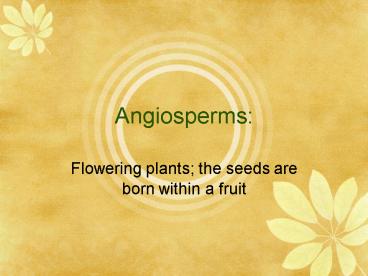Angiosperms: - PowerPoint PPT Presentation
1 / 25
Title:
Angiosperms:
Description:
The flower produces microspores within anthers and megaspores within ovules by meiosis. ... The portion of the flower that consists of a filament and an anther ... – PowerPoint PPT presentation
Number of Views:981
Avg rating:3.0/5.0
Title: Angiosperms:
1
Angiosperms
- Flowering plants the seeds are born within a
fruit
2
Facts about angiosperms
- They are the most abundant plants on earth today
- They are the most diverse plants on earth today
3
Facts about angiosperms
- 240,000 known species6 times the number of
species of all other plant groups combined - Live in all sorts of habitats, from fresh water
to desert, from icy north to steamy tropics - Size ranges from almost microscopic to over 100
meters tall
4
Why are angiosperms important to us?
- They provide us with clothing, food, medicines,
and other commercially valuable products. - Can you think of a few cash crops that are
angiosperms?
5
Important terms
- Diploid- cell condition in which two of each type
of chromosome is present - Ovules- the structure that contains the female
gametophyte and has the potential to develop into
a seed - Pollen tube- a tube that forms when a pollen
grain lands on the stigma and germinates. The
tube grows, passing between the cells of the
stigma and the style to reach the egg inside the
ovule, where fertilization occurs - Gametophyte- haploid generation of the
alternation of generations life cycle in a plant
produces gametes that unite to form a diploid
zygote
6
Alternation of generations
- The sporophyte bears flowers. The flower
produces microspores within anthers and
megaspores within ovules by meiosis. A megaspore
becomes a female gametophyte, which produces an
egg within an embryo sac, and a microspore
becomes a male gametophyte (pollen grain), which
produces sperm. Fertilization results in a
seed--enclosed zygote, and stored food.
7
Generalized flower parts
- Petals (Corolla)
- Stamen
- Anther
- Filament
- Style
- Stigma
- Ovary
- Pistil (Carpel)
- Sepal (Calyx)
8
Generalized flower parts
- Petals (Corolla)
- A flower part that occurs just inside the sepals
often conspicuously colored to attract
pollinators.
9
Generalized flower parts
- Stamen
- The portion of the flower that consists of a
filament and an anther containing pollen sacs
where pollen is produced
10
Generalized flower parts
- Anther
- Pollen-bearing portion of the stamen
- Filament
- The elongated stalk of a stamen
11
Generalized flower parts
- Stigma
- Portion of the carpel where pollen grains adhere
and germinate before fertilization can occur - Style
- Elongated, central portion of the carpel between
the ovary and the stigma
12
Generalized flower parts
- Pistil (carpel)
- Ovule-bearing unit of the flowering plant
stigma, style, and ovary together - Ovary
- The enlarged, ovule-bearing portion of the carpel
that develops into a fruit
13
Generalized flower parts
- Sepal
- Outermost, sterile, leaf-like covering of the
flower usually green in color
14
Whats in a name?
- We call these plants angiosperms because their
ovules are contained within diploid tissue
(unlike gymnosperms) - Angio comes from Greek meaning vessel this
refers to the ovary which forms a fruit. This is
a unique angiosperm feature
15
Ovule of angiosperm
16
Pollination of Angiosperms
- Occurs via insect,
- Or via animal,
- Or via wind,
- Even by water!
17
Lifecycle of an orange
- Oranges and citrus fruits are very popular around
the world. Navel oranges are actually quite
rare! Those annoying seeds are vital.
18
Stage 1 Seeds
- The seeds are scattered by wind, animals, or
water. With fruit like oranges, most likely they
are distributed by animals. Can you guess how?
19
Stage 2 Germination
- When the weather is right and there is enough
(but not too much) water the seed begins to
germinate. - What three things does a seed need to germinate?
Water Oxygen Correct temperature
20
Stage 3 Seedling
- The plant begins to grow its first leaves and
stems. The plant is still fragile at this time.
21
Stage 4 Juvenile
- The plant grows very quickly, putting on new
leaves, stems, and branches.
22
Stage 5 Flowering
- Growth slows as the plant begins to produce
flowers - Flowering can be triggered by the time of year or
the weather, particularly temperature
23
Stage 6 Pollination
- Pollen grains are taken from flower to flower by
bees and other flying insects. The mixing of
pollen in known as pollination.
24
Stage 7 Fruiting
- After a flower has been pollinated, the flower
grows into a seed and fruit.
25
Stage 8 Dispersal
- Animals (including us) eat the fruit, taking the
seeds away from the orange tree.































